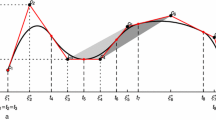Abstract
Automatic curve fitting using splines has been widely used in data analysis and engineering applications. An important issue associated with data fitting by splines is the adequate selection of the number and location of the knots, as well as the calculation of the spline coefficients. Typically, these parameters are estimated separately with the aim of solving this non-linear problem. In this paper, we use a hierarchical genetic algorithm to tackle the B-spline curve fitting problem. The proposed approach is based on a novel hierarchical gene structure for the chromosomal representation, which allows us to determine the number and location of the knots, and the B-spline coefficients automatically and simultaneously. Our approach is able to find optimal solutions with the fewest parameters within the B-spline basis functions. The method is fully based on genetic algorithms and does not require subjective parameters like smooth factor or knot locations to perform the solution. In order to validate the efficacy of the proposed approach, simulation results from several tests on smooth functions and comparison with a successful method from the literature have been included.



Similar content being viewed by others
Notes
The source files for the BARS algorithm were coded in C with wrapper to R software [21] and can be downloaded from http://www.stat.cmu.edu/~kass/bars/bars.html. See [25] for a complete description of this algorithm.
References
H. Akaike, A new look at the statistical model identification. IEEE Trans. Autom. Control 19, 716–723 (1974)
M. Bessaou, A. Pétrowski, P. Siarry, in PPSN VI: Proceedings of the 6th International Conference on Parallel Problem Solving from Nature. Island Model Cooperating with Speciation for Multimodal Optimization (Springer, Berlin, 2000), pp. 437–446
K. Deb, R.B. Agrawal, Simulated binary crossover for continuous search space. Complex Syst. 9, 115–148 (1995)
C. De Boor, A Practical Guide to Splines (Springer, New York, 1978)
C. De Boor, On calculating with B-spline. J. Approx. Theory 6, 50–62 (1972)
D.G.T. Denison, B.K. Mallick, A.F.M. Smith, Automatic Bayesian curve fitting. J. R. Stat. Soc. Ser. B Stat. Methodol. 60, 333–350 (1998)
I. Dimatteo, C.R. Genovese, R.E. Kass, Bayesian curve-fitting with free-Knot splines. Biometrika 88(4), 1055–1071 (2001)
J.H. Friedman, Multivariate adaptive regression splines (with discussion). Ann. Stat. 19(1), 1–141 (1991)
J.H. Friedman, B.W. Silverman, Flexible parsimonious smoothing and additive modeling. Technometrics 31, 3–39 (1989)
A. Gálvez, A. Iglesias, Efficient particle swarm optimization approach for data fitting with free knot B-splines. Comput. Aided Des. 43(12), 1683–1692 (2011)
D.E. Goldberg, Genetic Algorithms in Search, Optimization, and Machine Learning (Addison-Wesley Professional, Boston, MA, 1989)
T.J. Hastie, R.J. Tibshirani, Generalized Additive Models (Chapman & Hall CRC, London, 1990)
J.H. Holland, Adaptation in Natural and Artificial Systems: An Introductory Analysis with Applications to Biology, Control, and Artificial Intelligence (The MIT Press, Cambridge, 1992)
J.Y. Koo, Spline estimation of discontinuous regression functions. J. Comput. Graph. Stat. 6, 266–284 (1997)
T.C.M. Lee, Smoothing parameter selection for smoothing splines: a simulation study. Comput. Stat. Data Anal. 42(1–2), 139 (2003)
T.C.M. Lee, On algorithms for ordinary least squares regression spline fitting: a comparative study. J. Stat. Comput. Simul. 72(8), 647–663 (2002)
T.C.M. Lee, Regression spline smoothing using the minimum description length principle. Stat. Probab. Lett. 48(1), 71–82 (2000)
K.-F. Man, K.-S. Tang, S. Kwong, Genetic Algorithms: Concepts and Designs with Disk (Springer-Verlag New York Inc, Secaucus, 1999)
L. Pingping, Z. Xiuyang, Y. Bo, in International Conference on Future Computer and Communication (ICFCC). Automatic Knot Adjustment by an Improved Genetic Algorithm, vol. 3, pp. 763–768 (2010)
J. Pittman, Adaptive splines and genetic algorithms. J. Comput. Graph. Stat. 11(3), 615–638 (2002)
R Development Core Team, R: A Language and Environment for Statistical Computing, R Foundation for Statistical Computing, Vienna, Austria, ISBN: 3-900051-07-0, http://www.R-project.org (2009)
M. Smith, R. Kohn, Nonparametric regression using Bayesian variable selection. J. Econ. 75(2), 317–343 (1996)
M. Tomassini, Spatially Structured Evolutionary Algorithms: Artificial Evolution in Space and Time (Natural Computing Series) (Springer-Verlag New York Inc, Secaucus, 2005)
G. Wahba, Spline Models for Observational Data, SIAM [Society for Industrial and Applied Mathematics], vol. 169 (1990)
G. Wallstrom, J. Liebner, R.E. Kass, An implementation of Bayesian adaptive regression splines (BARS) in C with S and R wrappers. J. Stat. Softw. 26(1), 1–21 (2007)
F. Yoshimoto, T. Harada, Y. Yoshimoto, Data fitting with a spline using a real-coded genetic algorithm. Comput. Aided Des. 35(8), 751–760 (2003)
F. Yoshimoto, M. Moriyama, T. Harada, in Proceedings of the International Conference on Shape Modeling and Applications. Automatic Knot Placement by a Genetic Algorithm for Data Fitting with a Spline (IEEE Computer Society Press, 1999), pp. 162–169
M. Zamani, A simple piecewise cubic spline method for approximation of highly nonlinear data. Nat. Sci. 4, 79–83 (2012)
X. Zhao, C. Zhang, B. Yang, P. Li, Adaptive knot placement using a GMM-based continuous optimization algorithm in B-spline curve approximation. Comput. Aided Des. 43(6), 598–604 (2011)
Acknowledgments
We acknowledge the support of the Consejo Nacional de Ciencia y Tecnología de México, Centro de Investigaciones en Óptica, A.C. and Instituto Tecnológico Superior de Irapuato. This work has been partially funded by the CONACYT Project 229839 (Apoyo al Fortalecimiento y Desarrollo de la Infraestructura Científica y Tecnológica 2014) and the DAIP Project 444 (Convocatoria Institucional de Investigación Científica 2014).
Author information
Authors and Affiliations
Corresponding author
Rights and permissions
About this article
Cite this article
Garcia-Capulin, C.H., Cuevas, F.J., Trejo-Caballero, G. et al. A hierarchical genetic algorithm approach for curve fitting with B-splines. Genet Program Evolvable Mach 16, 151–166 (2015). https://doi.org/10.1007/s10710-014-9231-3
Received:
Revised:
Published:
Issue Date:
DOI: https://doi.org/10.1007/s10710-014-9231-3




